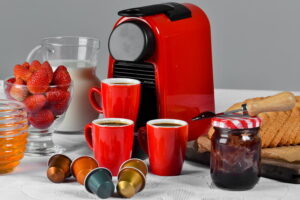Let’s say you are hankering for a latte or a good old cappuccino. Now, the ideal way to make it would be to prepare your coffee and then add the milk afterward. However, this sounds like a lot of work. Can’t you just add milk directly to the coffee maker? What happens if you put milk in a coffee maker?
Contents
What Happens if You Put Milk in a Coffee Maker?
When you put milk in a coffee maker, the milk will be heated to a higher than normal temperature. This will cause your coffee to taste bad since very hot milk loses its original taste. The milk residue will also encourage the growth of bacteria inside the machine, making it unhygienic.
Coffee makers are typically designed to heat water as high as 205 Fahrenheit. On the other hand, steamed milk for coffee should be about 155-165 Fahrenheit. Heating milk any higher will make it lose its original flavor and taste bad.

Milk usually begins to scald at about 160 degrees Fahrenheit. When you heat it beyond this point, the proteins will start to denature or change shape. This change in shape will cause the milk to thicken and clump up. The fats will also start to solidify, which will make the milk greasy and unpleasant to drink.
The water in the milk will evaporate at a higher rate than usual since it’s being heated. This will make the milk more concentrated and cause it to have a burnt taste. The lactose in the milk will also start to caramelize, giving the coffee an unpleasant sweetness.
Why You Shouldn’t Put Milk in a Coffee Maker
That said, you should avoid putting milk in a coffee maker because:
- It will make your coffee taste terrible
- It’s unhygienic since the milk residue will encourage bacteria growth
- It can damage your coffee maker since the milk will solidify and clog up the machine
It Will Make Your Coffee Taste Terrible
Good milk for coffee is usually heated to about 160 degrees Fahrenheit. However, coffee makers are designed to heat water to around 195-205 degrees Fahrenheit.
This means that if you put milk straight into your coffee maker, it will be heated to a temperature that is too high for milk. This will cause the milk to curdle and make your coffee taste terrible.
It’s Unhygienic and Unhealthy
Since milk contains proteins and sugars, it is a perfect breeding ground for bacteria. If you don’t clean your coffee maker regularly, the milk residue will encourage bacteria growth. This will make subsequent coffee taste and probably cause food poisoning.
It Can Damage Your Coffee Maker
If you put milk in your coffee maker, the milk will solidify and clog up the machine. This happens when milk is heated to a temperature that is too high. The milk will solidify and form a thick deposit that will clog up your coffee maker and potentially damage it.

Alternative Ways to Add Milk to Coffee
As you can see, adding milk directly to your coffee maker may not be a good idea. While you can save some time, you will also potentially spoil your coffee, damage your coffee maker and expose yourself to food poisoning.
So, what should you do instead? I recommend two alternatives:
- Heat milk separately and add to your coffee afterward
- Use an Espresso machine with a milk frother
Method 1: Heat Milk Separately
The best thing to do if you are making coffee at home is to first heat the milk separately in a saucepan and then add it to the coffee later.
To do this:
- Pour milk into a saucepan and heat it over low to medium heat until it reaches the desired temperature
- Reduce the temperature once your milk comes to a boil
- Let it simmer for 2 to 3 minutes
- Add it to your coffee and enjoy
Method 2: Use an Espresso Machine With a Milk Frother
If you want to avoid the hassle of heating milk separately, you can use an espresso machine with a built-in milk frother. These machines are designed to heat milk to the perfect temperature for coffee while also frothing it so that it is creamy and evenly blended. This tastes better than when you heat your own milk.
Using an espresso machine, you can make different types of coffee such as cappuccino, latte, or mocha.
Related Questions
Is It Safe to Put Milk in Coffee Maker?
No, it’s not safe to put milk in a coffee maker because the milk will curdle and make your coffee taste terrible. Additionally, it’s unhygienic and unhealthy since the milk residue will encourage bacteria growth, and it can damage your coffee maker since the milk will solidify and clog up the machine.
What Would Happen if You Brewed Coffee With Milk Instead of Water?
If you brew coffee with milk instead of water, you’ll end up with a cup of coffee that tastes like milk. The coffee will be weaker because the milk doesn’t extract as much flavor from the beans. You might also end up with curdled milk if you don’t brew it at the right temperature.
Conclusion
Adding milk directly to your coffee maker will not only make your coffee taste bad but also clog your coffee maker and encourage bacterial growth. You should either heat the milk separately and add it to your coffee afterward or use an espresso machine with a built-in milk frother. This will give you a better-tasting cup of coffee, prolong your coffee maker’s lifespan and avoid any potential health hazards.



